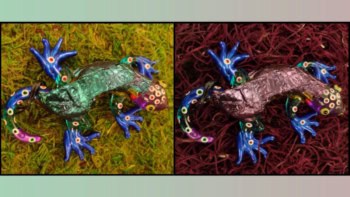
Solitons – non-dispersive wavepackets – are key features of nonlinear optics and other nonlinear wave systems. Theoreticians have long predicted that solitons can bind together to form “molecules” – and experiments have confirmed this in simple cases. Now, researchers in Germany and the US have analysed the spectra of soliton molecules multiple times as they ricocheted between the mirrors of a laser cavity – gaining remarkable insights into the dynamics of pairs and even triplets of solitons.
Light in optical fibres normally behaves as the linear sum of its frequency components. Laser pulses therefore gradually spread out as different frequencies travel at different speeds in a fibre. At high powers, however, the refractive index of glass fibre becomes nonlinear, so higher-intensity pulses propagate more slowly. This acts to push pulses together and, under specific conditions, the two effects can balance each other to create solitons – waves that travel forever without dispersing.
These nonlinear effects can also allow different light pulses to influence each other. “You have two balanced pulses that, when they come into each other’s sphere of influence, start bouncing off each other like lightsabers!” says Claus Ropers of the University of Göttingen. Under some conditions, they can also form bound states.
Relative motion
Soliton molecules have been previously observed in laser cavities, but only when the pulses moved in lockstep. “If you have two soliton pulses that are circulating stably in a cavity, you can see that simply from the optical spectrum of the laser,” explains Ropers. Decades of simulations have suggested this scenario, with pulses moving stably, is a subset of a much broader, richer range of mathematically possible soliton dynamics. However, soliton pairs in constant relative motion had never previously been observed in real time.
“Once the solitons start moving, the optical spectrum of the laser is completely washed out,” says Ropers, “You don’t see anything. Basically, you need to measure the optical spectrum of every laser shot.” With the solitons bouncing back and forth at the speed of light, however, this is a near-impossible task.
In the new research, Ropers and colleagues at the University of Göttingen and the University of California, Los Angeles, developed an ingenious and relatively simple technique they call “real-time spectral interferometry”. Each time the solitons bounce against the partial mirror of their laser cavity, a small proportion of the light escapes down a kilometre-long optical fibre. “This very little extracted energy doesn’t have enough intensity to create nonlinear effects in the fibre, so [the pulses] just see the dispersion,” explains team member George Herink. “The pulses therefore disperse in time until they overlap. When they overlap they interfere, and then the spectral patterns encode the original timing.” This allowed the team to capture a movie of soliton evolution with a shutter speed of just a few nanoseconds.
High-power triplets
The researchers first created two solitons in an optical cavity and manoeuvred them closer until they formed a static bound state. They also looked at solitons with fixed relative positions, but with a continually evolving relative phase. Soliton pairs whose relative positions changed continuously were also made, as Herink explains: “The first pulse is more intense, so it runs a bit slower because of the nonlinear refractive index. The second pulse therefore catches up: when they get close enough, another nonlinear effect makes them repel again. This kind of stuff can happen continuously, and what we see in our data is two pulses continuously changing their distance.” The team also observed soliton triplets at very high powers, and found that, when they turned the power down slightly, the triplet became a pair of solitons.
The researchers now intend to investigate their solitons in more detail. “This work is a kaleidoscope of the phenomena that you can actually see,” says Ropers. “We describe a range of different solutions, but there’s a lot more in terms of the physics of this and what exactly causes these dynamics.” He says this set-up acts as an “analogue simulator” of soliton dynamics, which appear in many other physical systems, some of which – such as Bose–Einstein condensates in ultracold gases – are much harder to investigate experimentally. Beyond this, Herink says that, if the researchers can control the evolution of the time lag between two pulses, this could be useful to chemists using pump-probe spectroscopy to follow ultrafast reaction dynamics.
The research is described in Science.



